The Role of Cost Accounting Systems in Promoting Sustainability
VerifiedAdded on 2023/04/20
|6
|1384
|51
Essay
AI Summary
This essay provides a critical analysis of different cost accounting systems, including marginal costing, traditional costing, and activity-based costing (ABC), and their impact on sustainability. It discusses the advantages and disadvantages of each system, using the United Steel Group from Saudi Arabia as an example of a company utilizing ABC. The analysis demonstrates how ABC can provide insights into product profitability and inform decisions that align with sustainability principles, such as optimizing production to focus on more profitable and sustainable products. The essay concludes that ABC, when effectively implemented, can enhance a company's sustainability efforts by providing accurate cost information for strategic decision-making. Desklib is your go-to platform for accessing similar solved assignments and study resources to excel in your academic journey.
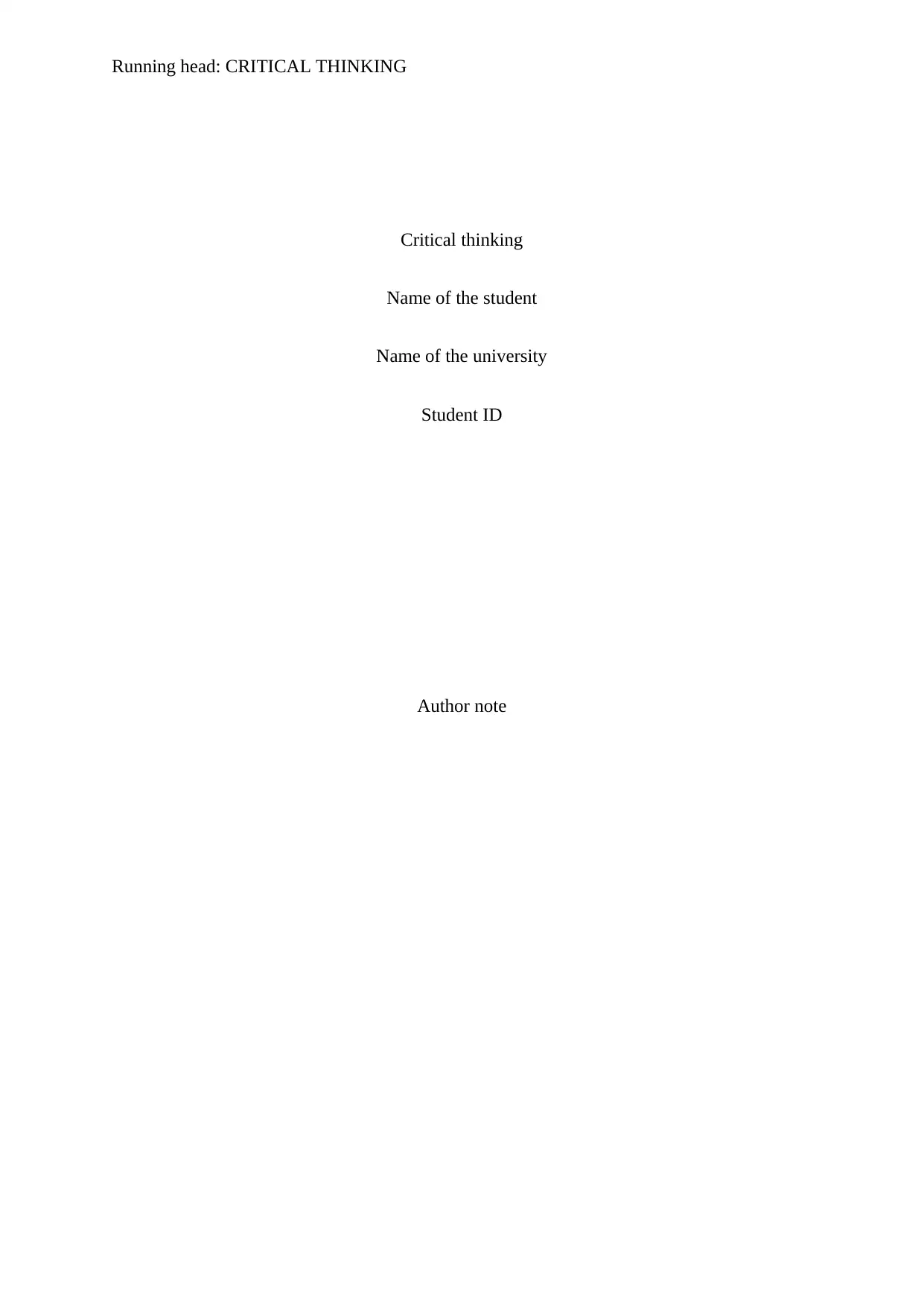
Running head: CRITICAL THINKING
Critical thinking
Name of the student
Name of the university
Student ID
Author note
Critical thinking
Name of the student
Name of the university
Student ID
Author note
Paraphrase This Document
Need a fresh take? Get an instant paraphrase of this document with our AI Paraphraser
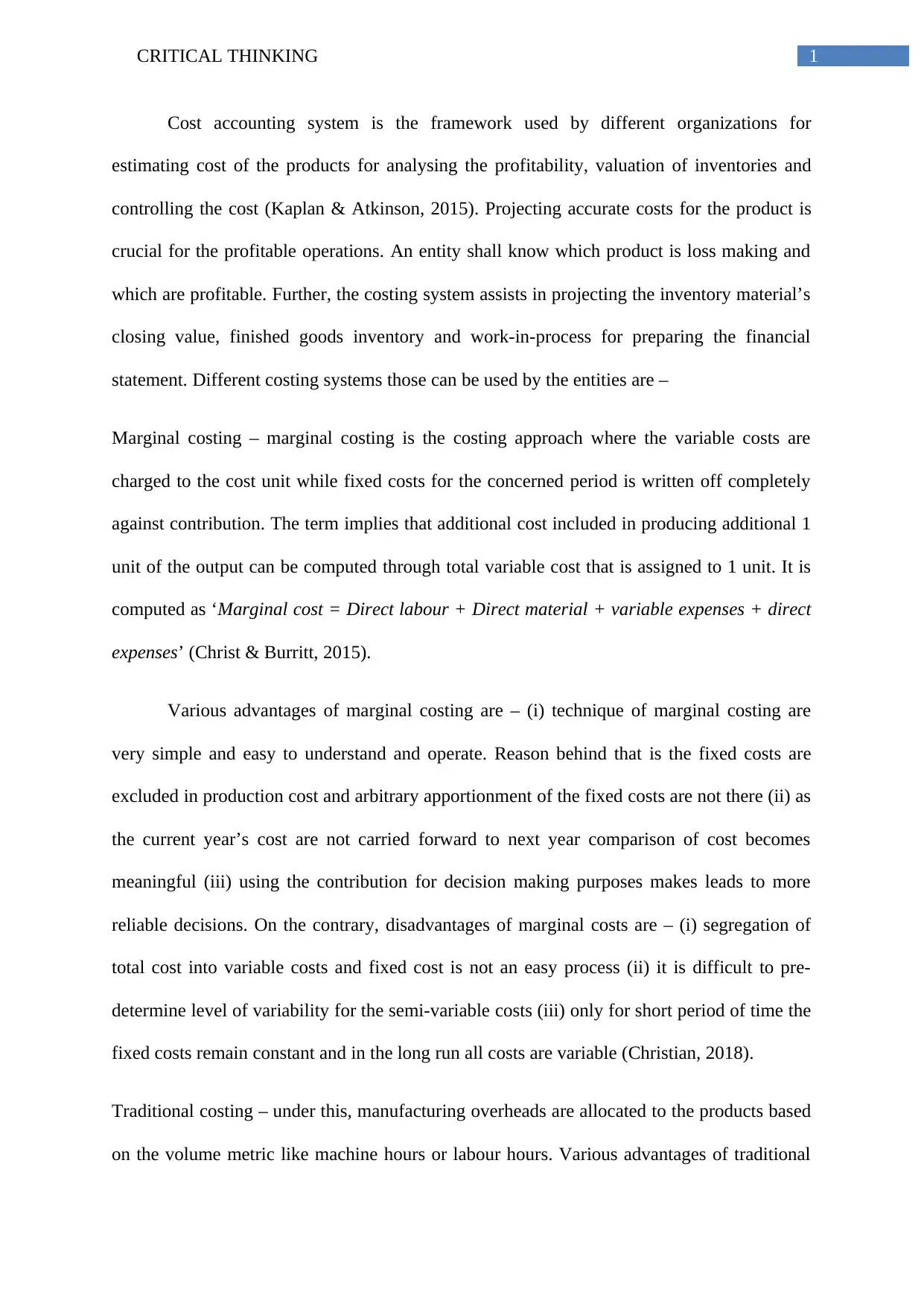
1CRITICAL THINKING
Cost accounting system is the framework used by different organizations for
estimating cost of the products for analysing the profitability, valuation of inventories and
controlling the cost (Kaplan & Atkinson, 2015). Projecting accurate costs for the product is
crucial for the profitable operations. An entity shall know which product is loss making and
which are profitable. Further, the costing system assists in projecting the inventory material’s
closing value, finished goods inventory and work-in-process for preparing the financial
statement. Different costing systems those can be used by the entities are –
Marginal costing – marginal costing is the costing approach where the variable costs are
charged to the cost unit while fixed costs for the concerned period is written off completely
against contribution. The term implies that additional cost included in producing additional 1
unit of the output can be computed through total variable cost that is assigned to 1 unit. It is
computed as ‘Marginal cost = Direct labour + Direct material + variable expenses + direct
expenses’ (Christ & Burritt, 2015).
Various advantages of marginal costing are – (i) technique of marginal costing are
very simple and easy to understand and operate. Reason behind that is the fixed costs are
excluded in production cost and arbitrary apportionment of the fixed costs are not there (ii) as
the current year’s cost are not carried forward to next year comparison of cost becomes
meaningful (iii) using the contribution for decision making purposes makes leads to more
reliable decisions. On the contrary, disadvantages of marginal costs are – (i) segregation of
total cost into variable costs and fixed cost is not an easy process (ii) it is difficult to pre-
determine level of variability for the semi-variable costs (iii) only for short period of time the
fixed costs remain constant and in the long run all costs are variable (Christian, 2018).
Traditional costing – under this, manufacturing overheads are allocated to the products based
on the volume metric like machine hours or labour hours. Various advantages of traditional
Cost accounting system is the framework used by different organizations for
estimating cost of the products for analysing the profitability, valuation of inventories and
controlling the cost (Kaplan & Atkinson, 2015). Projecting accurate costs for the product is
crucial for the profitable operations. An entity shall know which product is loss making and
which are profitable. Further, the costing system assists in projecting the inventory material’s
closing value, finished goods inventory and work-in-process for preparing the financial
statement. Different costing systems those can be used by the entities are –
Marginal costing – marginal costing is the costing approach where the variable costs are
charged to the cost unit while fixed costs for the concerned period is written off completely
against contribution. The term implies that additional cost included in producing additional 1
unit of the output can be computed through total variable cost that is assigned to 1 unit. It is
computed as ‘Marginal cost = Direct labour + Direct material + variable expenses + direct
expenses’ (Christ & Burritt, 2015).
Various advantages of marginal costing are – (i) technique of marginal costing are
very simple and easy to understand and operate. Reason behind that is the fixed costs are
excluded in production cost and arbitrary apportionment of the fixed costs are not there (ii) as
the current year’s cost are not carried forward to next year comparison of cost becomes
meaningful (iii) using the contribution for decision making purposes makes leads to more
reliable decisions. On the contrary, disadvantages of marginal costs are – (i) segregation of
total cost into variable costs and fixed cost is not an easy process (ii) it is difficult to pre-
determine level of variability for the semi-variable costs (iii) only for short period of time the
fixed costs remain constant and in the long run all costs are variable (Christian, 2018).
Traditional costing – under this, manufacturing overheads are allocated to the products based
on the volume metric like machine hours or labour hours. Various advantages of traditional
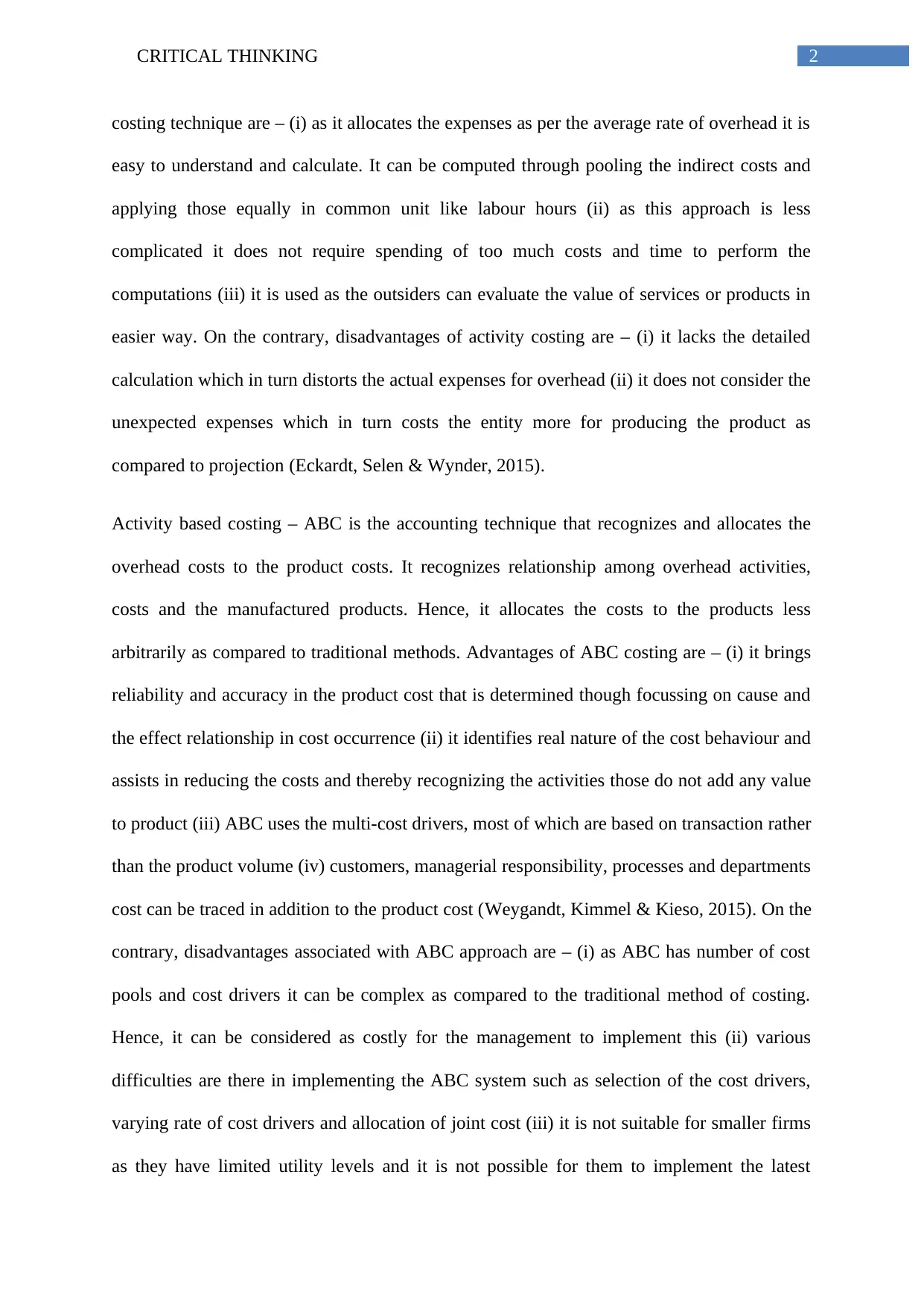
2CRITICAL THINKING
costing technique are – (i) as it allocates the expenses as per the average rate of overhead it is
easy to understand and calculate. It can be computed through pooling the indirect costs and
applying those equally in common unit like labour hours (ii) as this approach is less
complicated it does not require spending of too much costs and time to perform the
computations (iii) it is used as the outsiders can evaluate the value of services or products in
easier way. On the contrary, disadvantages of activity costing are – (i) it lacks the detailed
calculation which in turn distorts the actual expenses for overhead (ii) it does not consider the
unexpected expenses which in turn costs the entity more for producing the product as
compared to projection (Eckardt, Selen & Wynder, 2015).
Activity based costing – ABC is the accounting technique that recognizes and allocates the
overhead costs to the product costs. It recognizes relationship among overhead activities,
costs and the manufactured products. Hence, it allocates the costs to the products less
arbitrarily as compared to traditional methods. Advantages of ABC costing are – (i) it brings
reliability and accuracy in the product cost that is determined though focussing on cause and
the effect relationship in cost occurrence (ii) it identifies real nature of the cost behaviour and
assists in reducing the costs and thereby recognizing the activities those do not add any value
to product (iii) ABC uses the multi-cost drivers, most of which are based on transaction rather
than the product volume (iv) customers, managerial responsibility, processes and departments
cost can be traced in addition to the product cost (Weygandt, Kimmel & Kieso, 2015). On the
contrary, disadvantages associated with ABC approach are – (i) as ABC has number of cost
pools and cost drivers it can be complex as compared to the traditional method of costing.
Hence, it can be considered as costly for the management to implement this (ii) various
difficulties are there in implementing the ABC system such as selection of the cost drivers,
varying rate of cost drivers and allocation of joint cost (iii) it is not suitable for smaller firms
as they have limited utility levels and it is not possible for them to implement the latest
costing technique are – (i) as it allocates the expenses as per the average rate of overhead it is
easy to understand and calculate. It can be computed through pooling the indirect costs and
applying those equally in common unit like labour hours (ii) as this approach is less
complicated it does not require spending of too much costs and time to perform the
computations (iii) it is used as the outsiders can evaluate the value of services or products in
easier way. On the contrary, disadvantages of activity costing are – (i) it lacks the detailed
calculation which in turn distorts the actual expenses for overhead (ii) it does not consider the
unexpected expenses which in turn costs the entity more for producing the product as
compared to projection (Eckardt, Selen & Wynder, 2015).
Activity based costing – ABC is the accounting technique that recognizes and allocates the
overhead costs to the product costs. It recognizes relationship among overhead activities,
costs and the manufactured products. Hence, it allocates the costs to the products less
arbitrarily as compared to traditional methods. Advantages of ABC costing are – (i) it brings
reliability and accuracy in the product cost that is determined though focussing on cause and
the effect relationship in cost occurrence (ii) it identifies real nature of the cost behaviour and
assists in reducing the costs and thereby recognizing the activities those do not add any value
to product (iii) ABC uses the multi-cost drivers, most of which are based on transaction rather
than the product volume (iv) customers, managerial responsibility, processes and departments
cost can be traced in addition to the product cost (Weygandt, Kimmel & Kieso, 2015). On the
contrary, disadvantages associated with ABC approach are – (i) as ABC has number of cost
pools and cost drivers it can be complex as compared to the traditional method of costing.
Hence, it can be considered as costly for the management to implement this (ii) various
difficulties are there in implementing the ABC system such as selection of the cost drivers,
varying rate of cost drivers and allocation of joint cost (iii) it is not suitable for smaller firms
as they have limited utility levels and it is not possible for them to implement the latest
⊘ This is a preview!⊘
Do you want full access?
Subscribe today to unlock all pages.

Trusted by 1+ million students worldwide
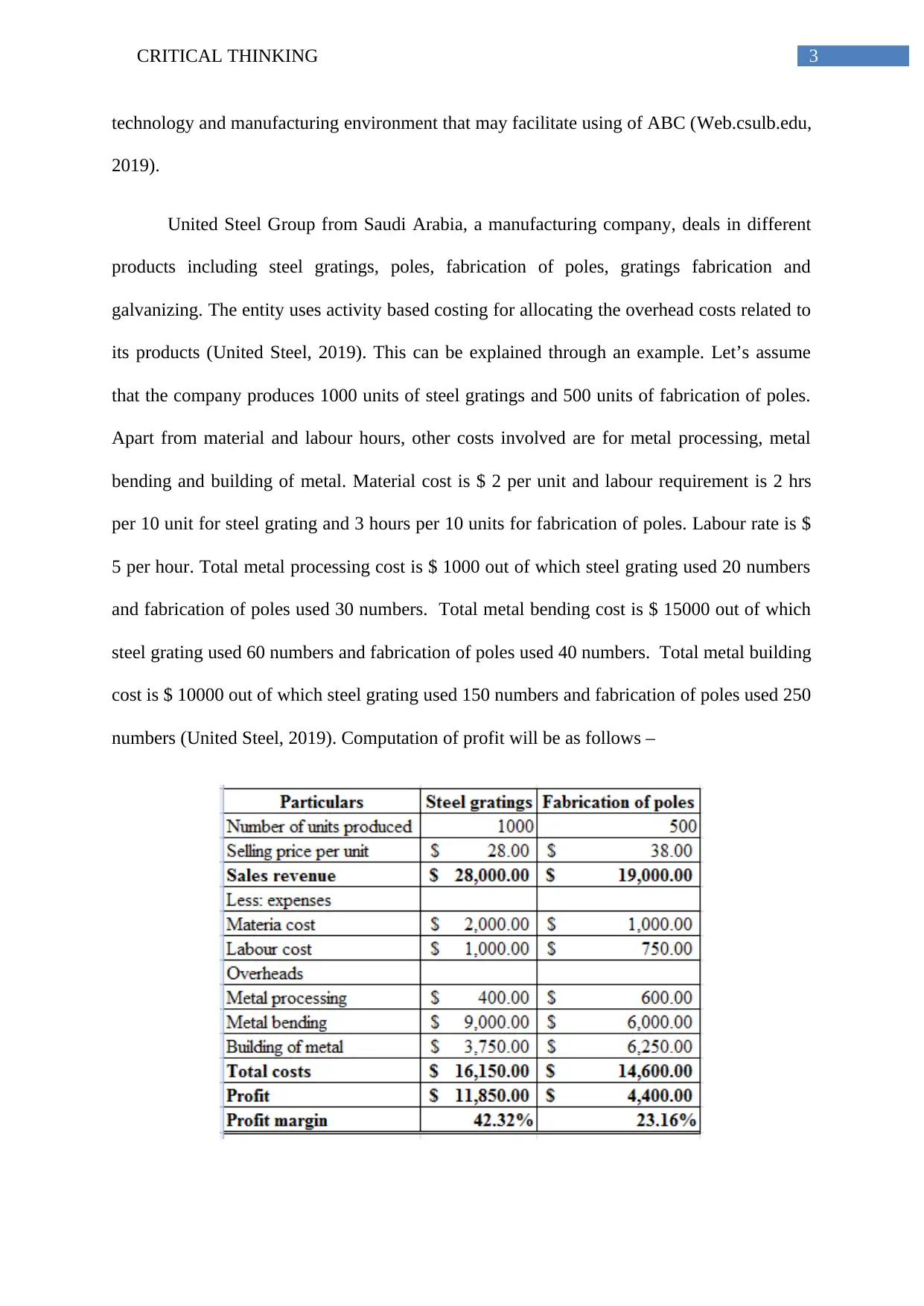
3CRITICAL THINKING
technology and manufacturing environment that may facilitate using of ABC (Web.csulb.edu,
2019).
United Steel Group from Saudi Arabia, a manufacturing company, deals in different
products including steel gratings, poles, fabrication of poles, gratings fabrication and
galvanizing. The entity uses activity based costing for allocating the overhead costs related to
its products (United Steel, 2019). This can be explained through an example. Let’s assume
that the company produces 1000 units of steel gratings and 500 units of fabrication of poles.
Apart from material and labour hours, other costs involved are for metal processing, metal
bending and building of metal. Material cost is $ 2 per unit and labour requirement is 2 hrs
per 10 unit for steel grating and 3 hours per 10 units for fabrication of poles. Labour rate is $
5 per hour. Total metal processing cost is $ 1000 out of which steel grating used 20 numbers
and fabrication of poles used 30 numbers. Total metal bending cost is $ 15000 out of which
steel grating used 60 numbers and fabrication of poles used 40 numbers. Total metal building
cost is $ 10000 out of which steel grating used 150 numbers and fabrication of poles used 250
numbers (United Steel, 2019). Computation of profit will be as follows –
technology and manufacturing environment that may facilitate using of ABC (Web.csulb.edu,
2019).
United Steel Group from Saudi Arabia, a manufacturing company, deals in different
products including steel gratings, poles, fabrication of poles, gratings fabrication and
galvanizing. The entity uses activity based costing for allocating the overhead costs related to
its products (United Steel, 2019). This can be explained through an example. Let’s assume
that the company produces 1000 units of steel gratings and 500 units of fabrication of poles.
Apart from material and labour hours, other costs involved are for metal processing, metal
bending and building of metal. Material cost is $ 2 per unit and labour requirement is 2 hrs
per 10 unit for steel grating and 3 hours per 10 units for fabrication of poles. Labour rate is $
5 per hour. Total metal processing cost is $ 1000 out of which steel grating used 20 numbers
and fabrication of poles used 30 numbers. Total metal bending cost is $ 15000 out of which
steel grating used 60 numbers and fabrication of poles used 40 numbers. Total metal building
cost is $ 10000 out of which steel grating used 150 numbers and fabrication of poles used 250
numbers (United Steel, 2019). Computation of profit will be as follows –
Paraphrase This Document
Need a fresh take? Get an instant paraphrase of this document with our AI Paraphraser
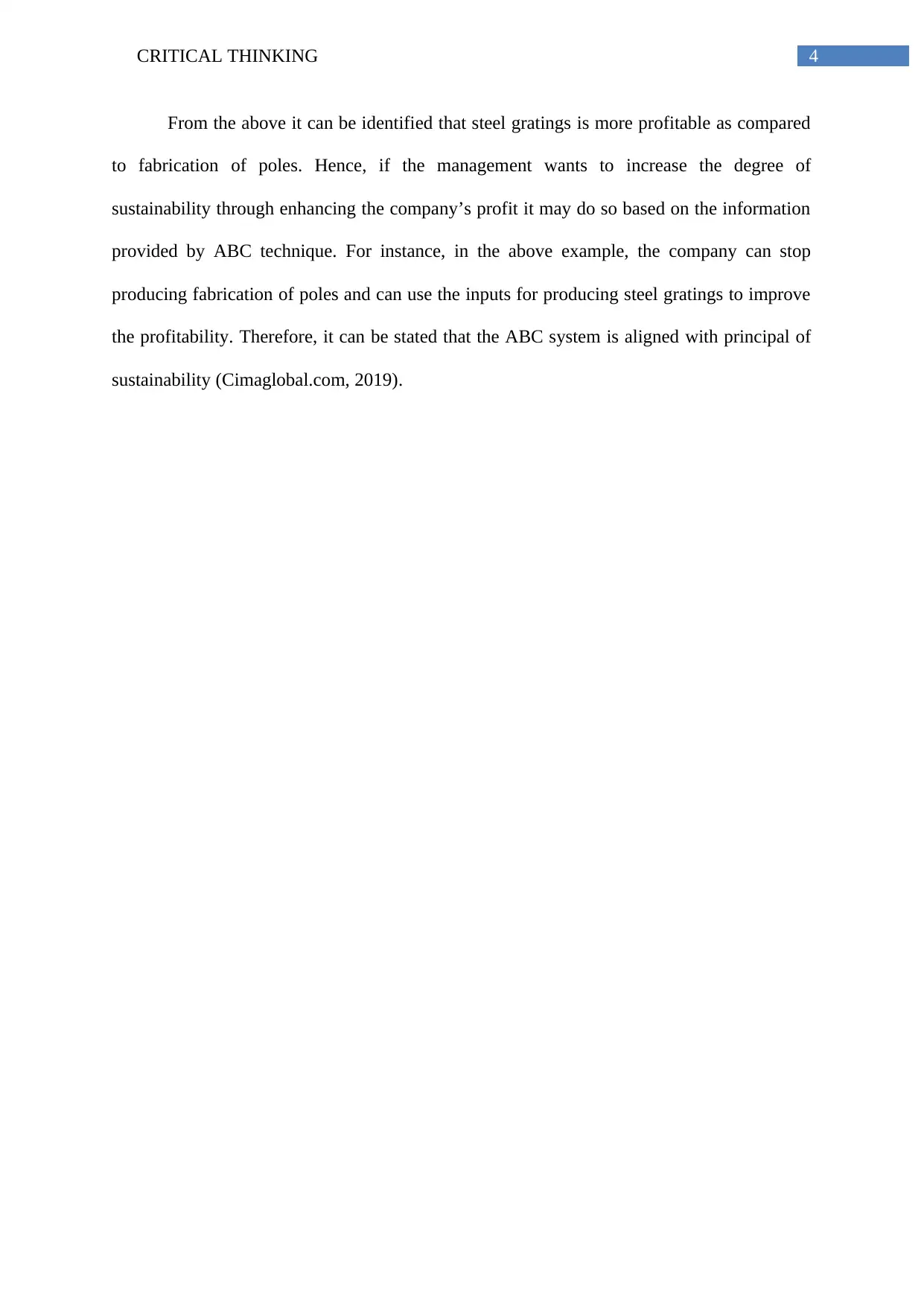
4CRITICAL THINKING
From the above it can be identified that steel gratings is more profitable as compared
to fabrication of poles. Hence, if the management wants to increase the degree of
sustainability through enhancing the company’s profit it may do so based on the information
provided by ABC technique. For instance, in the above example, the company can stop
producing fabrication of poles and can use the inputs for producing steel gratings to improve
the profitability. Therefore, it can be stated that the ABC system is aligned with principal of
sustainability (Cimaglobal.com, 2019).
From the above it can be identified that steel gratings is more profitable as compared
to fabrication of poles. Hence, if the management wants to increase the degree of
sustainability through enhancing the company’s profit it may do so based on the information
provided by ABC technique. For instance, in the above example, the company can stop
producing fabrication of poles and can use the inputs for producing steel gratings to improve
the profitability. Therefore, it can be stated that the ABC system is aligned with principal of
sustainability (Cimaglobal.com, 2019).
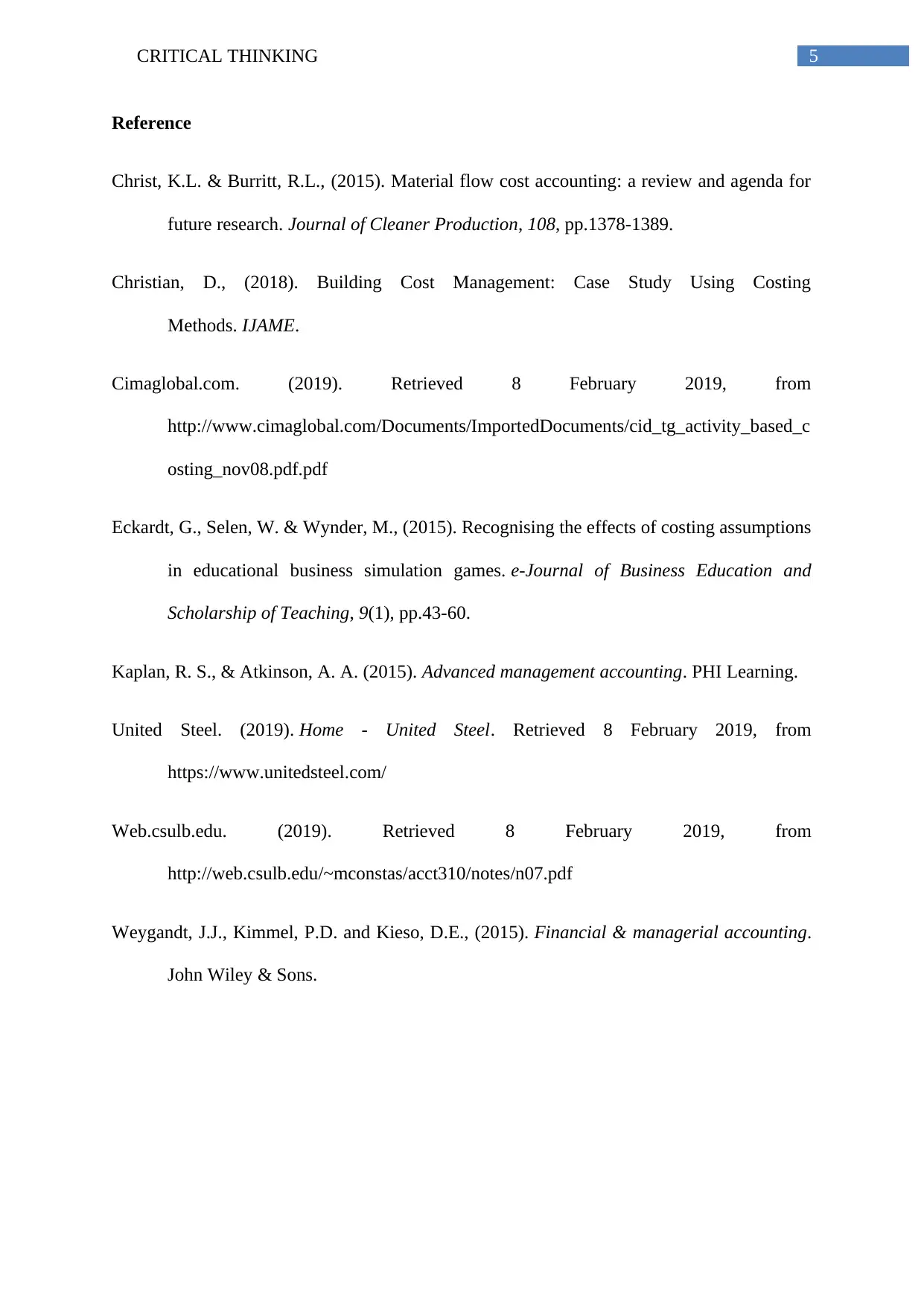
5CRITICAL THINKING
Reference
Christ, K.L. & Burritt, R.L., (2015). Material flow cost accounting: a review and agenda for
future research. Journal of Cleaner Production, 108, pp.1378-1389.
Christian, D., (2018). Building Cost Management: Case Study Using Costing
Methods. IJAME.
Cimaglobal.com. (2019). Retrieved 8 February 2019, from
http://www.cimaglobal.com/Documents/ImportedDocuments/cid_tg_activity_based_c
osting_nov08.pdf.pdf
Eckardt, G., Selen, W. & Wynder, M., (2015). Recognising the effects of costing assumptions
in educational business simulation games. e-Journal of Business Education and
Scholarship of Teaching, 9(1), pp.43-60.
Kaplan, R. S., & Atkinson, A. A. (2015). Advanced management accounting. PHI Learning.
United Steel. (2019). Home - United Steel. Retrieved 8 February 2019, from
https://www.unitedsteel.com/
Web.csulb.edu. (2019). Retrieved 8 February 2019, from
http://web.csulb.edu/~mconstas/acct310/notes/n07.pdf
Weygandt, J.J., Kimmel, P.D. and Kieso, D.E., (2015). Financial & managerial accounting.
John Wiley & Sons.
Reference
Christ, K.L. & Burritt, R.L., (2015). Material flow cost accounting: a review and agenda for
future research. Journal of Cleaner Production, 108, pp.1378-1389.
Christian, D., (2018). Building Cost Management: Case Study Using Costing
Methods. IJAME.
Cimaglobal.com. (2019). Retrieved 8 February 2019, from
http://www.cimaglobal.com/Documents/ImportedDocuments/cid_tg_activity_based_c
osting_nov08.pdf.pdf
Eckardt, G., Selen, W. & Wynder, M., (2015). Recognising the effects of costing assumptions
in educational business simulation games. e-Journal of Business Education and
Scholarship of Teaching, 9(1), pp.43-60.
Kaplan, R. S., & Atkinson, A. A. (2015). Advanced management accounting. PHI Learning.
United Steel. (2019). Home - United Steel. Retrieved 8 February 2019, from
https://www.unitedsteel.com/
Web.csulb.edu. (2019). Retrieved 8 February 2019, from
http://web.csulb.edu/~mconstas/acct310/notes/n07.pdf
Weygandt, J.J., Kimmel, P.D. and Kieso, D.E., (2015). Financial & managerial accounting.
John Wiley & Sons.
⊘ This is a preview!⊘
Do you want full access?
Subscribe today to unlock all pages.

Trusted by 1+ million students worldwide
1 out of 6
Related Documents
Your All-in-One AI-Powered Toolkit for Academic Success.
+13062052269
info@desklib.com
Available 24*7 on WhatsApp / Email
![[object Object]](/_next/static/media/star-bottom.7253800d.svg)
Unlock your academic potential
Copyright © 2020–2025 A2Z Services. All Rights Reserved. Developed and managed by ZUCOL.




